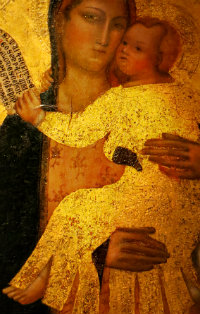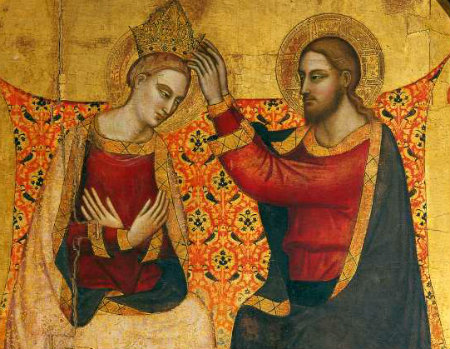Jacopo di Cione
1365-1398
Italian Late Gothic Byzantine Painter, Sculptor and Architect
Influences: Andrea Orcagna, Giotto Di Bondone , Cimabue, Coppo di Marcovaldo, and Carolingian Art
Education - apprenticed to his brother, Andrea Orcagna
Medium - Tempera on wood

Jacopo strove to capture the mysterious and mystical nature of Christianity. His highly formalized, linear Byzantine style Virgin has a piercingly beauty, with a melancholy look, and a crown and a golden halo. His depiction of the Virgin was as a caring mortal, a compassionate, loving mother against a background of bright gold. He was a younger brother and follower of Andrea Orcagna.
Most prominently featured in his work are the holy figures of the Christian faith--the -Christ, Saints, The Cross, Virgin Mary, Chalice, Keys, The Anchor, Wheat , The Good Shepherd, The Apostles, Animals, Fish, Angels, Birds, Insects and Satan.

With
the triumph of Christianity, Byzantine style artists aspired to
reawaken the divine spirit of holy figures rather than depict their
physical qualities. Their unique style is a combination
of frontal simplicity, truth to nature, harmonious unity together
with precision in details. The use of costly materials such as
gold, precious stones and ivory indicates the degree of wealth that was
common during this period, and attests to the sophistication of the
culture.
Eminent art historian and aurthor, Clive Bell
explains "Between 900 and 1200 the capital achievements of Christian
art are not superior in quality to those of the preceding age—indeed,
they fall short of the Byzantine masterpieces of the sixth century; but
the first-rate art of this second period was more abundant, or, at any
rate, has survived more successfully, than that of the first. The age
that has bequeathed us Romanesque, Lombardic, and Norman architecture
gives no sign of dissolution. We are still on the level heights of the
Christian Renaissance. Artists are still primitive. Men still feel the
significance of form sufficiently to create it copiously. Increased
wealth purchases increased leisure, and some of that leisure is devoted
to the creation of art. I do not marvel, therefore, at the common,
though I think inexact, opinion that this was the period in which
Christian Europe touched the summit of its spiritual history: its
monuments are everywhere majestic before our eyes."
.
| Byzantine 500-1450 | Romanesque 950-1250 | ||||||||||
| Gothic 1150-1580 | Florentine | ||||||||||
| Sienese School 1150-1550 | Venetian | ||||||||||
| Early Renaissance 1350-1500 | |||||||||||
| High Renaissance 1450-1530 | |||||||||||
| Northern Renaissance 1350-1600 | |||||||||||
| Mannerism 1510-1600 | |||||||||||
| Baroque 1600-1750 | |||||||||||
| Rococo 1710-1790 | |||||||||||
| Neoclassical 1740-1835 | |||||||||||
| Romanticism 1750-1860 | |||||||||||
| Hudson River School 1825-1880 | |||||||||||
| Orientalism 1800-1885 | |||||||||||
| Academic Classicism 1865-1920 | |||||||||||
| Victorian Classicism 1845-1895 | |||||||||||
| Pre-Raphaelite 1840-1855 | |||||||||||
Impressionism
1860-1895
|
Require more information about Cimabue in Art History? Type your query in art into the google search box below and poke around every nook and cranny of the known universe for information this subject.
Do you know something we don't? If you have comment or would like to share an insight regarding Cimabue in Art History, please submit your comment to the editor, via e-mail and if possible site the source. Thank you!
© HistoryofPainters.com If you like this page and wish to share it, you
are welcome to link to it, with our thanks.
| links | artist biographies | top 50 painters | art supplies | book store |
| site map | art movements | artist quotations | iconography | 100 greatest paintings |